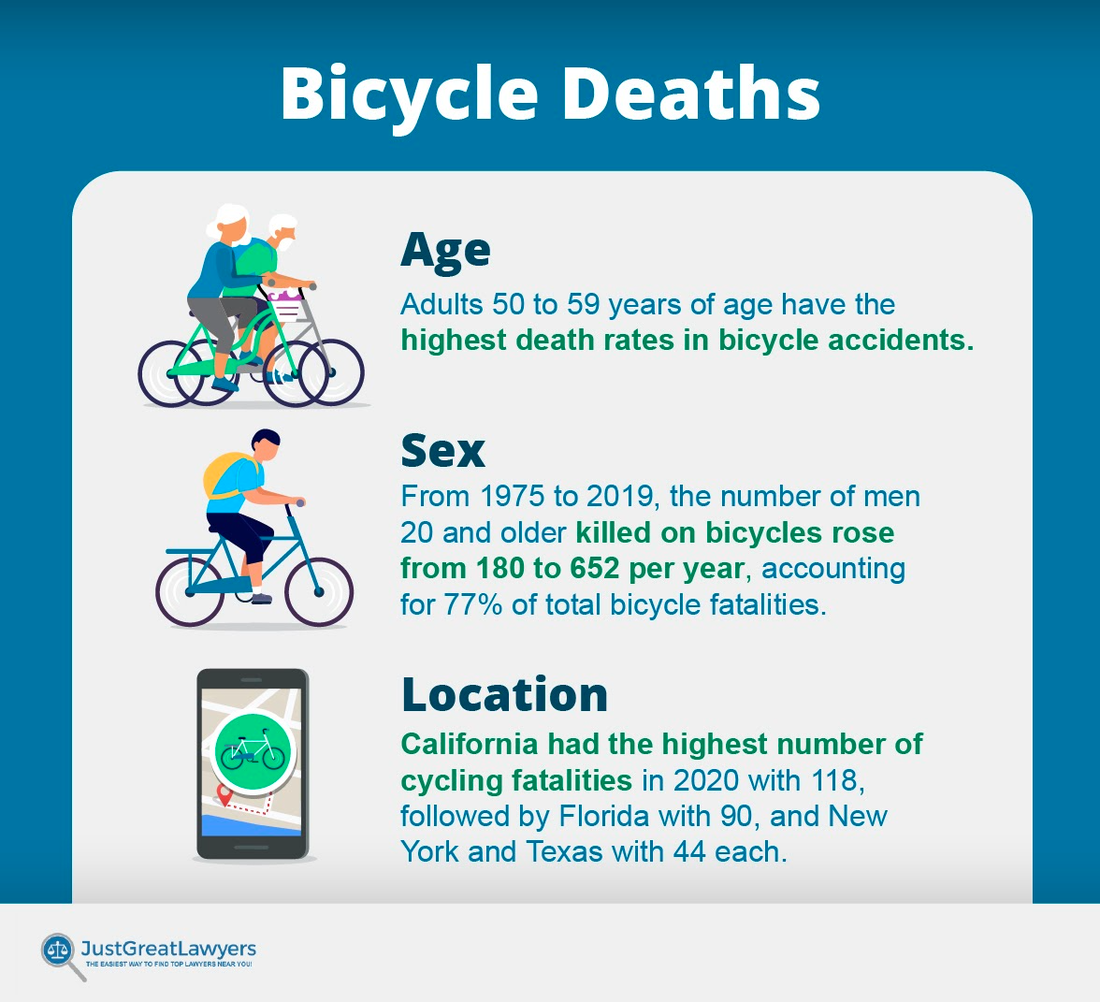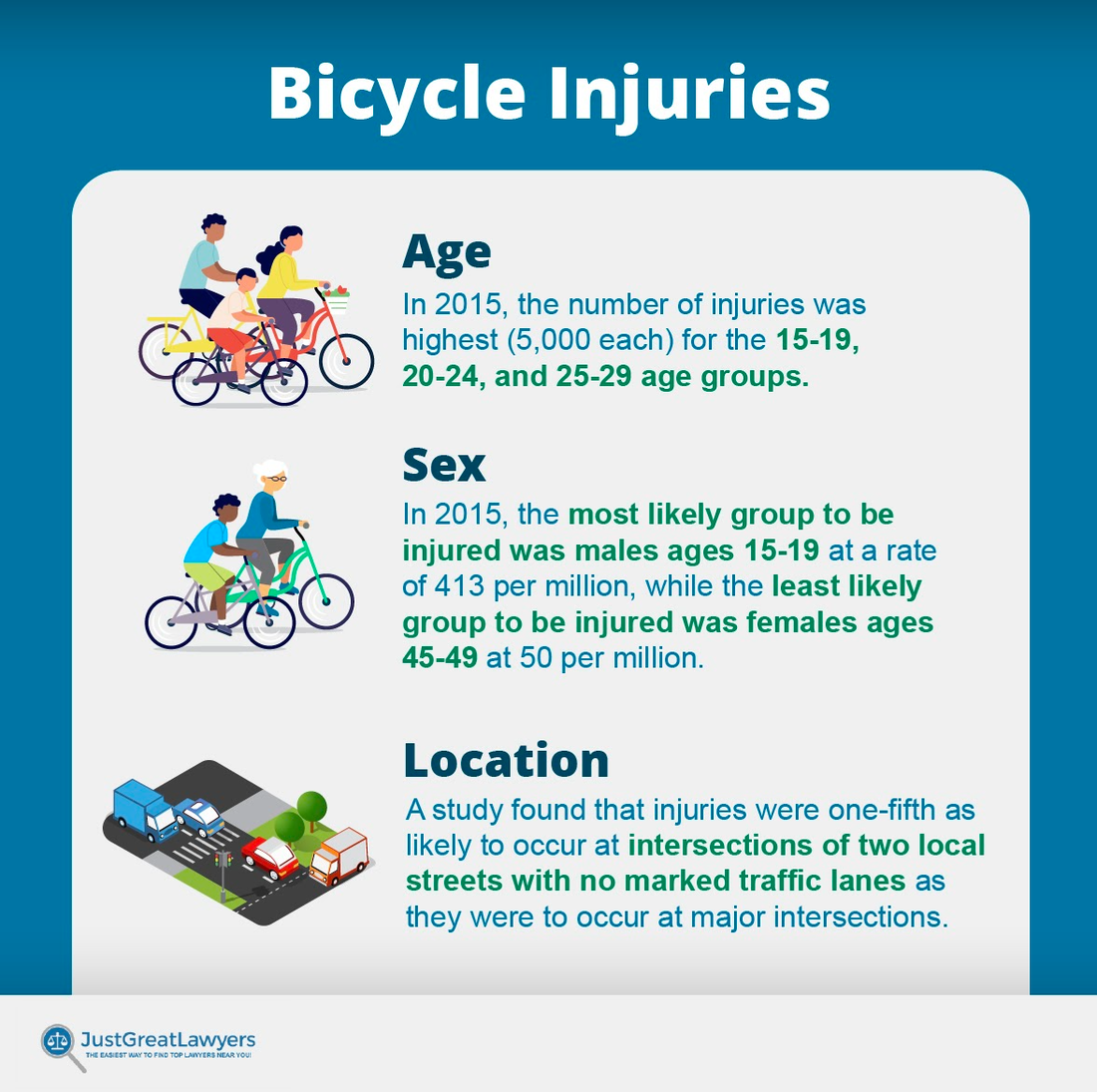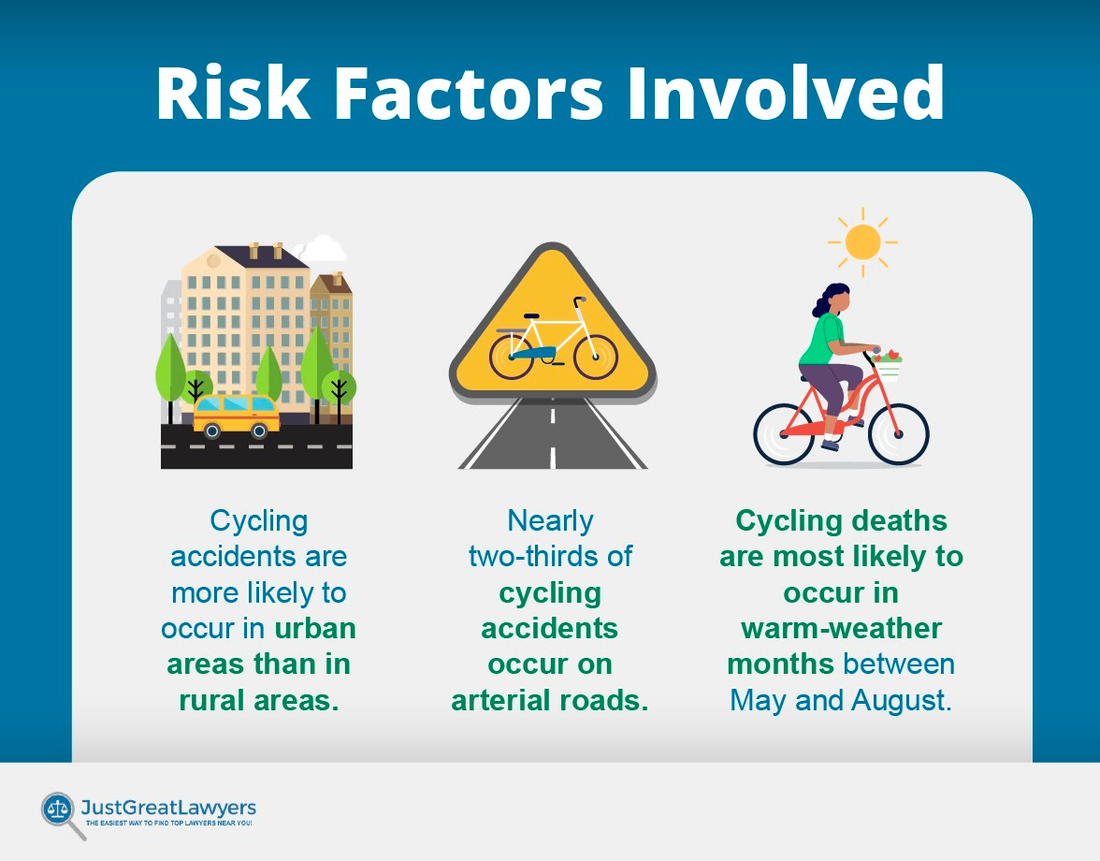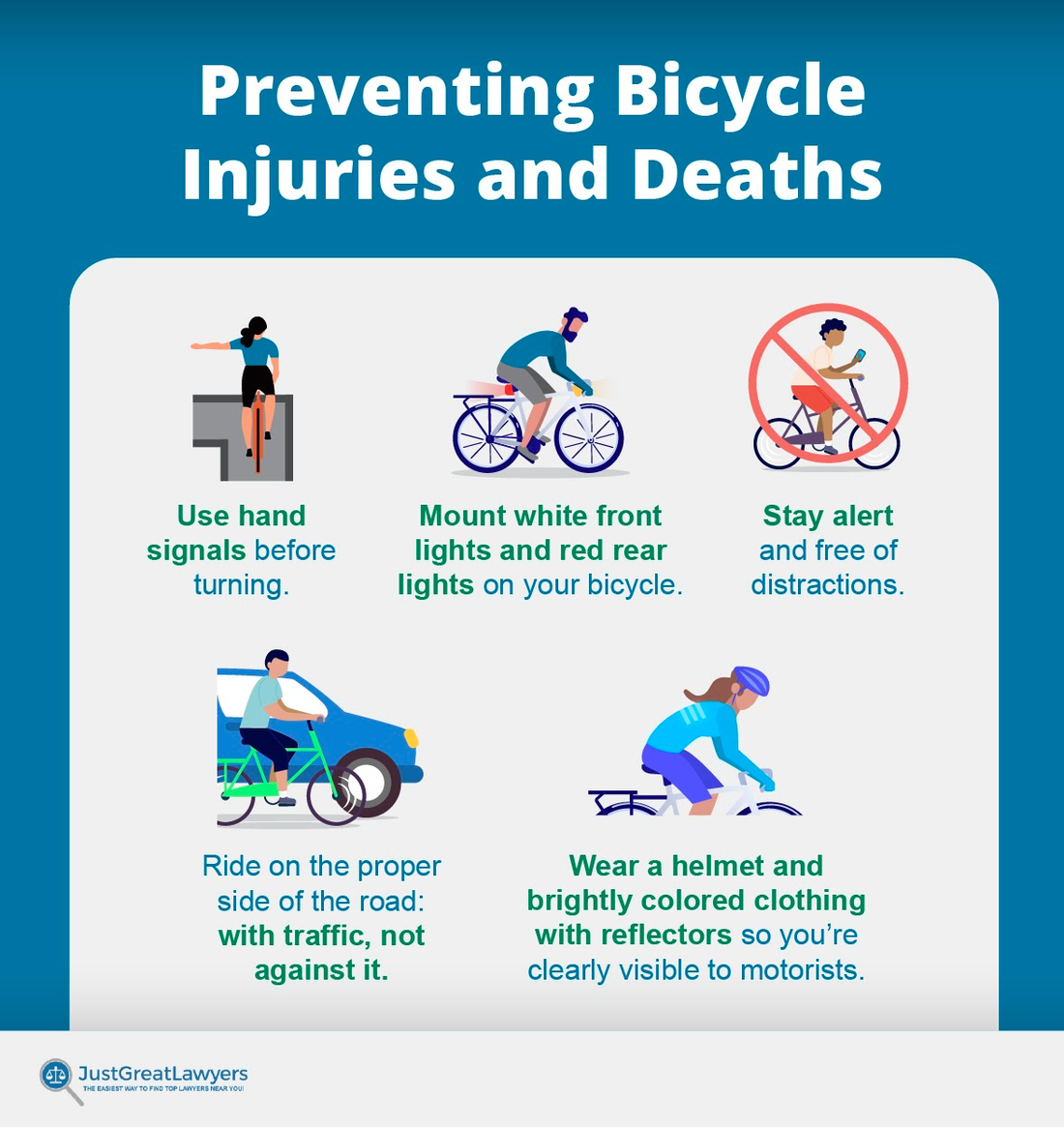
If you’re riding a bicycle on the road, you have reason to be cautious. According to bicycle accident statistics from the National Highway Traffic Safety Administration (NHTSA), 623 cyclists died nationwide in 2010 compared with 871 in 2018, an increase of roughly 40%.
The vast majority of bike accidents aren’t crashes with other vehicles: Riders are much more likely to get hurt by falling or hitting something else that isn’t moving. There are a number of ways to minimize the risk of cycling injuries, including obeying the rules of the road, choosing the proper bike, wearing a helmet that fits properly, staying alert, and maintaining good posture while riding.
If you are in an accident, depending on the circumstances, it may be useful to reach out to a lawyer to find out your rights.

The number of cyclists killed in traffic crashes fell slightly (by 2.9%) between 2018 and 2019, but it marked the fifth straight year that the number of cycling fatalities surpassed 800. The number of bicyclist fatalities fell significantly to 675 in 2020, but that was likely due to the COVID-19 pandemic.
More than a quarter of bicyclist deaths in 2020 were caused by hit-and-run accidents. Time of day was also somewhat predictive: Fatal accidents were most common between 6 p.m. and 9 p.m.
Just 5% of bicycle fatalities involved children younger than 14.
Adults 50 to 59 years of age have the highest death rates in bicycle accidents.
A total of 101 cyclists ages 50 to 59 were killed in 2019, 92 of whom were men.
The next-highest numbers were 90 killed in the 60-64 age group, 82 in the 50-54 group, and 80 in the 65-69 group.
In all, 353 cyclists between the ages of 50 and 69 were killed in 2019, accounting for 41% of the total.
Since 1975, the number of male cyclists younger than 20 involved in fatal accidents has declined steadily, from 638 in 1975 to just 67 in 2019.
That group now makes up 8% of the total.
In the same period, the number of men 20 and older killed on bicycles has risen from 180 to 652, to account for 77% of the total.
Females younger than 20 have also seen a drop, from 148 in 1975 to just 12 in 2019, which is a mere 1% of the total.
Women ages 20 and older accounted for 3% of the total in 1975 with 32 fatalities.
The same group in 2019 accounted for 13% of fatalities with 107 deaths.
In 2015, 85% of cyclists killed were males.
Cyclist fatalities rose by 49% in urban areas from 2010 to 2019.
Cyclist deaths in rural areas were up by 4.6% during the same decade.
California had the highest number of cycling fatalities in 2020 with 118, followed by Florida with 90, and New York and Texas with 44 each.
Louisiana, which ranked fifth with 34 deaths in 2020, had the lowest number of cycling deaths per capita, with 7.3 per 1 million residents.
In 2020, 35% of cycling deaths occurred in urban areas, 31.9% in suburban areas, and 33.1% in rural areas.
Also in 2020, 65.4% of cycling deaths occurred on arterial roads, 15.6% on highways, and 10.3% in residential areas.
The deadliest roads in the country for cyclists in 2020 included Beach Boulevard in Huntington Beach, California (a suburb of Los Angeles); Military Trail in West Palm Beach, Florida; and First and Second avenues in Manhattan.
In 2015, the cyclist percentage of overall fatalities was highest in Vermont at 7% and lowest in West Virginia and Montana at 0.4%.

Although the number of deaths among cyclists declined from 2018 to 2019, the injury rate increased by 4.3%, as 2,000 more cyclists were hurt than in the year before. Except where noted, the statistics on injuries by age and sex were taken from the NHTSA’s 2019 report on Traffic Safety Facts for Bicyclists and Other Cyclists.
Children ages 5-14 and adolescents 15-20 years old were most likely to have nonfatal injuries in bicycle accidents in 2019.
Together, these two groups account for more than one-third of patients treated at emergency rooms for bike-related injuries.
From 2006 to 2015, the average age of cyclists injured increased from 30 to 35, per the NHTSA’s 2015 report on Traffic Safety Facts for Bicyclists and Other Cyclists.
In 2019, the number of injuries was highest (8,000 each) for the 15-20 age group, followed by 5,000 each for the 10-14 and 25-29 age groups.
The injury rate was highest in the 15-20 age group at 32 per 100,000.
The injury rate was also over 20 per 100,000 for the 10-14, 21-24, and 25-29 age groups.
The number of injuries was lowest for the 70-74 age group at 1,000.
The injury rate was the lowest — 6 per 100,000 — for the 70-74 age group, and 8 per 100,000 for the 5-9 age group.
In 2019, 82% of cyclists injured were males.
A total of 40,000 male cyclists were injured.
By comparison, 9,000 female cyclists were injured.
The injury rate was 25 per 100,000 for males.
The rate was 5 per 100,000 for females.
The most likely group to be injured was males ages 15-19 at a rate of 51 per 100,000.
The least likely group to be injured was females 35-44 at 5 per 100,000.
In Texas, 69% of nonfatal injuries to cyclists occurred on city streets in 2019.
In Illinois, 2,353 injuries occurred in urban areas in 2019; the number in rural areas was just 27.
A study in Vancouver and Toronto found that injuries were just one-fifth as likely to occur at intersections of two local streets with no marked traffic lanes as they were to occur at major intersections (with more than two traffic lanes).
The same study found increased risks on downhill grades and traffic circles.
Helmet laws are a matter of state and local jurisdiction; there’s no national federal law governing the use of helmets.
The first state laws and local ordinances were passed in 1987, with most jurisdictions focusing on mandatory helmets for children younger than 16, although some place the upper age at 14, 16, or 17, and a few municipalities require helmets for all ages.
By December 2011, the Bicycle Helmet Safety Institute reported that a total of 21 states, along with the District of Columbia and 201 local entities, had adopted child helmet laws.
A 2001 analysis of all research studies published between 1987 and 1998 found that helmet use cut the fatality rate by about 73% and reduced total head injuries (including brain injury), by about 60%.

A number of factors play into the risk of cyclist injury or death. Here are when, where, and how bicycle accidents commonly occur:
Cycling accidents are more likely to occur in urban areas than in rural areas.
They are more likely to occur in highly populated states.
Nearly two-thirds of cycling accidents occur on arterial roads.
Cycling deaths are most likely to occur at non-intersection sites.
Alcohol use by either the cyclist or motor vehicle driver is a factor in 37% of fatal bicycle accidents.
Males are more likely to be involved in such traffic accidents than females: They’re more than six times as likely to die and they’re injured four times as often.
Cycling deaths are most likely to occur in warm-weather months between May and August. (Hit-and-run totals also tend to be highest during these months.)

Bicycle accidents can result from several different factors, sometimes in combination with one another. A number of things can be done to help prevent bicycle injuries and deaths. Avoiding collisions is one thing, cutting down on accidents caused by falls is another, and reducing the likelihood of major injury through the use of such measures as helmets is also worth considering.
Steps you as a cyclist can take include:
Using hand signals before you turn.
Riding on the proper side of the road: with traffic, not against it.
Wearing brightly colored clothing and reflectors so you’re clearly visible to motorists.
Mounting white front lights and red rear lights on your bicycle.
Ensuring that your helmet fits properly.
Making sure your bike is the right size for you.
Keeping your bike in good working condition.
Staying alert and free from distractions (not wearing headphones, for instance).
Tucking your pants and shoelaces in so they don’t get tangled in your bike’s chain or spokes.
Staying off sidewalks and in bike lanes where they’re available.
Bicyclists are more vulnerable on the road than motor vehicle users, so if you’re riding a bike you need to take extra precautions to avoid accidents such as motor vehicle crashes that can cause death or serious injuries.
It’s important to be aware of your surroundings and the fact that accidents are more likely to occur at certain times and places than at others. Reducing risk factors is also important.
If you’ve already been in an accident, contact a lawyer to determine your next steps. An attorney can advise you concerning things such as liability, compensatory damages, and whether you may qualify to receive damages for pain and suffering. Many attorneys offer free consultations.
